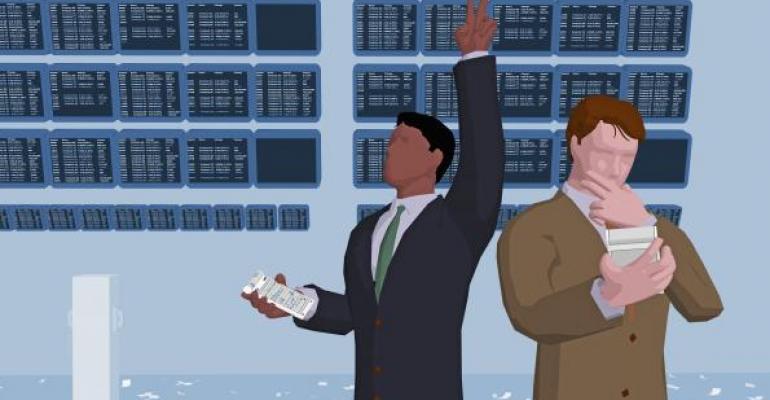In physics, motion is described as the change in the position of an object with respect to both time and its reference point -- where it began and where it ended up. If the object or body is not changing with respect to either time or reference point then it is said that the body is at rest. As we know from Newton’s first law, a body or object will remain at rest or at its current rate of change until acted upon by an external force. In nonscientific terms, if something were sitting motionless the only way for it to move would be if something were to come along and give it a nudge.
U.S. rates are beginning to look like a body at rest. Rates have been contained within very narrow trading ranges, roughly 10 basis points, over the last three weeks. In looking at the 10-year U.S. Treasury rate, trading has gone virtually nowhere in over 12 days as the close on 10/29 (2.31%) was 1 basis point from where we are trading right now, at 2.32%. The front of the curve is no different: The 2-year Treasury is trading within 1 basis point (.0.51%) during the same time period.
There are a couple of reasons for the lack of activity. First, investors are clearly confused around monetary policy and the timeline tied to stimulus reduction. The specter of rising rates has created pause for many investors as they balance the deployment of cash against the chance for higher rates in the future. Second, we are beginning to see that many investors have achieved their targets for the year and are already positioned for the end of the year. Other factors, including liquidity, have played their part as well.
So does this mean that trading is done for the year? Most likely not. If history is any precursor, elongated periods of inactivity often lead to large price movements as the activity breaks the current range and establishes a new equilibrium. Once the “body at rest” begins to move, especially after being dormant for so long, the movement can be dramatic.
One of the technical measures of volatility (realized price volatility) that I monitor has dropped to levels where we could see such movement. The lower the level of price movement, the lower the volatility readings. The last two times we had price volatility drop to these levels, we saw rate move 30 bps or more. Late August saw rates sell off by 30 basis points as the 10-year went from 2.35% to 2.60%, and similar volatility readings in mid-September saw rates rally in excess of 50 basis points as 10-year rates fell below 2.00%.
Will we get rate moves of this magnitude? That remains to be seen, but the recognition that the conditions are similar to those we saw in August and September clearly has us keeping a close eye on trading.
In looking at the U.S. yield curve, the lack of movement this week has resulted in small changes in all of the curve relationships. The spread between 2-year and 10-year Treasuries increased by 1.5 basis points, finishing the week at 181 basis points. The lack of movement in rates is resulting in similarly low levels of volatility. I would frame the 2-year/10-year relationship at 180 to 190 basis points.
Asian equities were higher this week by 1 to 2 percent as trading was buoyed by tied to the delay of the consumption tax. The Asian Review reported that Japan Prime Minister Abe is moving a step closer to postponing the increase in consumption tax (from 8% to 10%) and quotes a senior government official who discussed the internal debate. Japanese preliminary Q3 GDP is scheduled to be released late on Sunday and there are concerns around weak results that could drive Abe to reconsider the timing of the tax increase.
In Europe the big event of the week was the release of European Q3 GDP data. Germany averted a recession by the narrowest of margins, with GDP growing by 0.1% in Q3, and France also showed some improvement. However, the report still showed that weakness remains in the periphery as Italy slipped back into recession and Portugal fell short of expectations. Euro stocks were generally skewed toward positive results this week on very light volume.
U.S. risk assets continued to push towards new highs as the better than expected retail sales numbers (0.30% vs. expectations of 0.20% for October) helped to assuage fears that equities have pushed too far. The energy sector was a drag on trading (energy sector names were down 6 to 8 percent) as oil prices had their longest weekly decline since 1986. Credit spreads were largely unchanged this week on moderate volumes.
Global sovereign rates saw yield movements much larger than what we experienced domestically. British Gilts were the best performer among the tier-one European sovereigns as rates fell by 9 basis points. German Bunds rallied by 1.5 basis points as trading pushed back through the 0.80% level, finishing on Friday at 0.78%. The ongoing concerns around the triple-dip European recession coupled with the trillion-Euro stimulus program by the ECB will likely limit the rise of European rates. The spread between Bunds and Treasuries finished the week at 154 basis points as the spread widened by 6 basis points.
As we close the week the stage appears to be set for an exciting finish to the year. Record short positions in 10-year futures, muted volumes in most financial markets, and an unbalanced global growth picture are all forces that could set the market in motion. The low volatility tell us little in regard to the market’s directionality while indicating that there is an environment where we could see a big move.
Sean Fallon, CFA, is Senior Vice President of Stephens Inc. He joined Stephens in July 2012 to head the Municipal Taxable efforts and to trade CMBS, Agency CMBS, and ABS.





